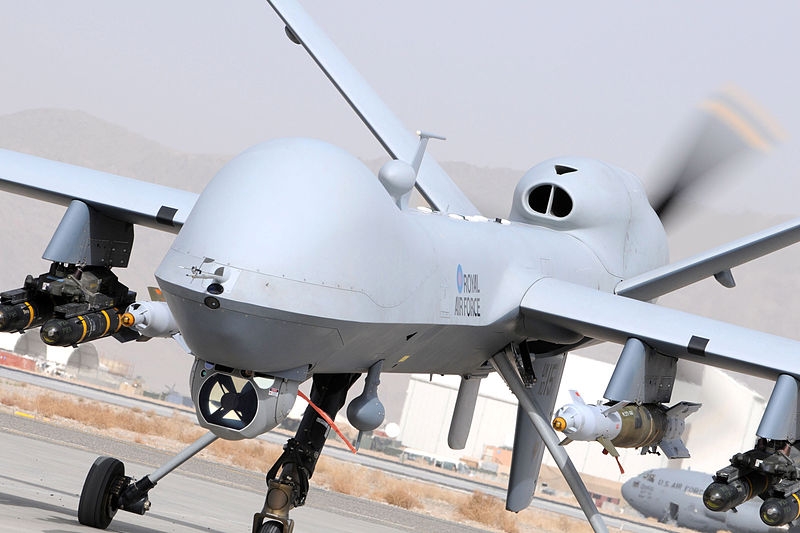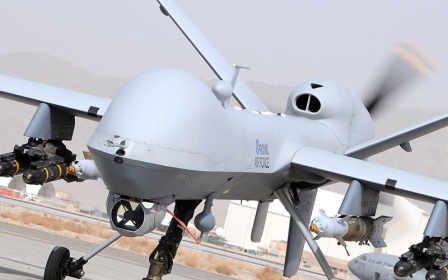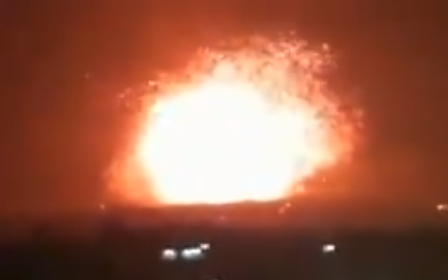UK drones in Syria using controversial 'vacuum' bombs

Britain's defence ministry have acknowledged using controversial thermobaric missiles in Syria that rights groups have described as "indiscriminate".
Royal Air Force drones used the weapons, often called "vacuum" bombs because they suck oxygen into the powerful blast, against targets in Syria in January and February of this year, an FOI request sent by Drone Wars UK, a campaign group, has revealed.
The missiles work by sucking in oxygen from the environment to create a high-temperature explosion with an extremely powerful blast radius. Unlike conventional explosives that cause injuries through shrapnel, the blast effect of thermobaric weapons causes internal organ damage including to the lungs.
RAF MQ-9 Reaper drones fired 19 AGM-114N missiles in January and February of this year. The 'N' variant of the AGM-114 missile, known as Hellfire missiles, contains a thermobaric warhead which is particularly effective at targeting people inside enclosed spaces such as buildings, fortifications or tunnels.
The exact cause of death from being hit by a thermobaric weapon would be multiple injuries to various organs including the lungs
- Justin Bronk, RUSI air power expert
The British government has in the past refused to acknowledge whether it has used the weapons in combat saying it could harm the effectiveness of the armed forces.
The revelations came on the same day that the British government admitted for the first time that its bombing campaign against Islamic State in Syria and Iraq killed civilians.
The MoD said a civilian who had entered the target area at the last minute was killed in Syria’s Euphrates Valley on 26 March when a Reaper drone struck a “terrorist vehicle” with a Hellfire missile. The MoD did not specify what type of Hellfire missile was used.
Justin Bronk, a research fellow at the Royal United Services Institute, said thermobaric weapons create an explosion significantly bigger than conventional weapons of similar size.
“What differentiates a thermobaric weapon from a conventional explosive is, whereas a conventional explosive is between 30 percent and 40 percent explosive… thermobaric weapons use nearly one-hundred percent explosive,” he said.
The weapons, also known as "enhanced blast weapons", disperse an explosive metallic powder into the air immediately before detonating. This then draws in oxygen from the air, creating a very powerful explosion.
'Particularly cruel wounds'
“[Thermobaric weapons] tend to kill via blast wave pressure rather than direct explosion or fragmentation damage which means it's enormously effective against things like bunkers or people in confined spaces,” Bronk said.
“The exact cause of death from being hit by a thermobaric weapon would be multiple injuries to various organs including the lungs,” he added.
While thermobaric weapons are legal, rights groups have said that their large blast area makes them indiscriminate weapons that should not be used in densely populated area.
A report by the United Nation Institute for Disarmament Research said that enhanced blast weapons, referring to a type of thermobaric weapon which includes those used by RAF drones, “raise additional humanitarian concerns that deserve focused attention”.
"So-called 'thermobaric weapons' generate high temperatures that can start fires, and can cause particularly cruel wounds to people within a wide area," the report said.
The number of strikes carried out by British drones in Syria greatly increased in 2018, figures seen by Middle East Eye show. UK drones fires as many weapons in the first three months of 2018 as they had fired over the previous 18 months.
Chris Cole, of Drone Wars UK, told MEE that the scale of UK operations since 2014 and the recent rise in drone strikes meant that the UK's announcement of one civilian death was “likely just the tip of the iceberg”.
He told MEE: “UK drone strikes have hugely intensified in Syria since January. In the first three months of 2018 UK drones fired as many weapons in Syria as they have done over the previous 18 months."
"Despite the MoD insisting that its drones are primarily for surveillance and intelligence gathering, UK Reaper drones have now fired more weapons in Syria than the UK's dedicated bomber, the Tornado.”
New MEE newsletter: Jerusalem Dispatch
Sign up to get the latest insights and analysis on Israel-Palestine, alongside Turkey Unpacked and other MEE newsletters
Middle East Eye delivers independent and unrivalled coverage and analysis of the Middle East, North Africa and beyond. To learn more about republishing this content and the associated fees, please fill out this form. More about MEE can be found here.




